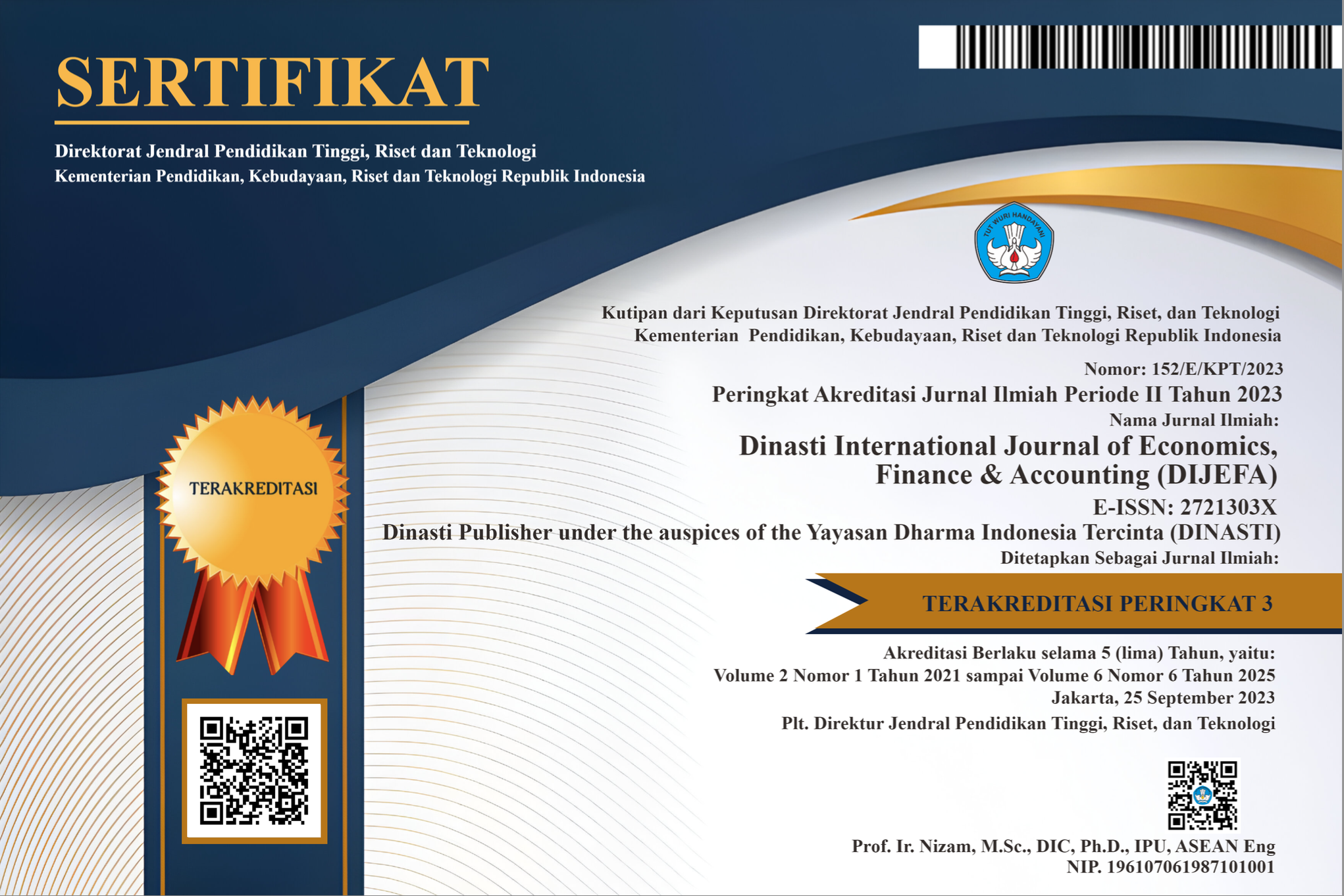Does Diversification Strengthen Or Weaken A Firm’s Performance On Stock Price?
DOI:
https://doi.org/10.38035/dijefa.v5i6.3795Keywords:
Diversification, Firm Performance, Stock Price, Financial Performance, ROA, PBVAbstract
This study examines the impact of diversification on a firm’s performance, specifically in relation to its stock price. The primary aim is to assess whether diversification strengthens or weakens the effect of financial performance on stock prices.The research uses Price-to-Book Value (PBV) as a measure of stock price and Return on Assets (ROA) as a measure of financial performance. The sample consists of 292 companies, with data analyzed through descriptive statistics, regression analysis, and ANOVA. The findings suggest that financial performance, as measured by ROA, has a significant positive effect on PBV, indicating that better financial performance tends to enhance a company's stock price. However, the study also explored whether diversification both international and industrial moderates this relationship. The results showed that while diversification strategies were prevalent in the sample, they did not significantly weaken or strengthen the relationship between ROA and PBV. These findings imply that while financial performance plays a crucial role in determining stock prices, diversification, in this context, does not have a notable moderating effect. This study contributes to the ongoing debate regarding the impact of diversification on firm performance, suggesting that, although diversification may reduce risk, it does not necessarily amplify the financial performance’s impact on stock prices. Further research could explore other factors influencing this relationship and test these findings across different industries and time periods.
References
Balakrishnan, K., Blouin, J. L., & Guay, W. R. (2019). Tax Aggressiveness and Corporate Transparency. The Accounting Review, 94(1), 45–69. https://doi.org/10.2308/accr-52130
Benkraiem, R., Ben-Nasr, H., Nechi, S., & Rjiba, H. (2023). Stock price crash risk and leverage dynamics: Evidence from the GCC countries. Finance Research Letters, 54, 103688. https://doi.org/10.1016/j.frl.2023.103688
Capital Group. (2023). The role of diversification in strategic financial management. Capital Insights. https://www.capitalgroup.com/institutional/insights/white-papers/international-equity-investing.html
Gyan, A. K., Brahmana, R., & Bakri, A. K. (2017). Diversification strategy, efficiency, and firm performance: Insight from emerging market. Research in International Business and Finance, 42, 1103–1114. https://doi.org/10.1016/j.ribaf.2017.07.045
Hartono, J. (2022). Teori portofolio dan analisis investasi. UGMPress.
Haug, J., & Pidun, U. (2013). Diversification and Competitive Advantage: A Risk-Based Explanation. Academy of Management Proceedings, 1, 13418. https://doi.org/10.5465/AMBPP.2013.13418
Jafarinejad, M., Ngo, T., & Escobari, D. (2018). Disentangling the impacts of industrial and global diversification on firm risk. Global Finance Journal, 37, 39–56. https://doi.org/10.1016/j.gfj.2018.04.006
Kuppuswamy, V., & Villalonga, B. (2016). Does Diversification Create Value in the Presence of External Financing Constraints? Evidence from the 2007–2009 Financial Crisis. Management Science, 62(4), 905–923. https://doi.org/10.1287/mnsc.2015.2165
Lee, J. W. (2014). Dynamic Relationship between Stock Prices and Exchange Rates: Evidence from Chinese Stock Markets. Journal of Asian Finance, 1(1), 5–14. https://doi.org/10.13106/jafeb.2014.vol1.no1.5
Matar, A., & Eneizan, B. (2018). Determinants of Financial Performance in the Industrial Firms: Evidence from Jordan. Asian Journal of Agricultural Extension, Economics & Sociology, 22(1), 1–10. https://doi.org/10.9734/AJAEES/2018/37476
Mukhopadhyay, J., & Chakraborty, I. (2017). Foreign institutional investment, business groups and firm performance: Evidence from India. Research in International Business and Finance, 39, 454–465. https://doi.org/10.1016/j.ribaf.2016.09.015
Prasetyo, B., Utami, S., Abdusshomad, A., Wijaya, M., & Kalbuana, N. (2021). Effect Of Company Value, Leverage, And Company Size On Profit Persistence In Jakarta Islamic Index (Jii) Listed Companies. International Journal of Economics, Business and Accounting Research (IJEBAR), 5(1). https://doi.org/10.29040/ijebar.v5i1.2164
Ramlawati, Liliasari, & Wulan, A. ratna. (2011). Improving Generic Science Skills of Chemistry Prospective Teachers through Implementation of Electronic Portfolio Assessment (APFE). International Seminar of Science Education.
Salindeho, A. O., Saerang, I. S., & Maramis, J. B. (2018). Pengaruh Diversifikasi Usaha Terhadap Kinerja Keuangan dan Return Saham Study Kasus pada Perusahaan Manufaktur Automotive And Component yang Terdaftar di BEI. Jurnal EMBA, 6(3), 1078–1087. https://doi.org/10.35794/emba.v6i3.20063
Shirodkar, V., Rajwani, T., Stadler, C., Hautz, J., & Mayer, M. C. J. (2022). Corporate Political Activity and Firm Performance: The Moderating Effects of International and Product Diversification. Journal of International Management, 28(4), 100941. https://doi.org/10.1016/j.intman.2022.100941
Spence, M. (1973). Job Market Signaling. The Quarterly Journal of Economics, 87(3), 355. https://doi.org/10.2307/1882010
Velte, P., Stawinoga, M., & Lueg, R. (2020). Carbon performance and disclosure: A systematic review of governance-related determinants and financial consequences. Journal of Cleaner Production, 254, 120063. https://doi.org/10.1016/j.jclepro.2020.120063
Wang, Q., Shen, J., & Ngai, E. W. T. (2023). Does corporate diversification strategy affect stock price crash risk? International Journal of Production Economics, 258, 108794. https://doi.org/10.1016/j.ijpe.2023.108794
Wegwu, M. E. (2020). Diversification Strategies and Business Performance in A Competitive Industry. A Multidisciplinary Peer Reviewed Journal, 6(8), 190–199.
Zhao, X., Lynch, J. G., & Chen, Q. (2010). Reconsidering Baron and Kenny: Myths and Truths about Mediation Analysis. Journal of Consumer Research, 37(2), 197–206. https://doi.org/10.1086/651257
Downloads
Published
How to Cite
Issue
Section
License
Copyright (c) 2025 Elvi Sekar Sari, Heru Tjaraka

This work is licensed under a Creative Commons Attribution 4.0 International License.
Authors who publish their manuscripts in this journal agree to the following conditions:
- The copyright on each article belongs to the author(s).
- The author acknowledges that the Dinasti International Journal of Economics, Finance & Accounting (DIJEFA) has the right to be the first to publish with a Creative Commons Attribution 4.0 International license (Attribution 4.0 International (CC BY 4.0).
- Authors can submit articles separately, arrange for the non-exclusive distribution of manuscripts that have been published in this journal into other versions (e.g., sent to the author's institutional repository, publication into books, etc.), by acknowledging that the manuscript has been published for the first time in the Dinasti International Journal of Economics, Finance & Accounting (DIJEFA).


























































